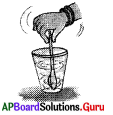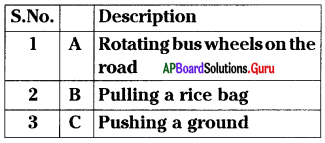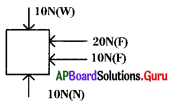Practice the AP 8th Class Biology Bits with Answers Chapter 2 Cell: The Basic Unit of Life on a regular basis so that you can attempt exams with utmost confidence.
AP State Syllabus 8th Class Biology Bits 2nd Lesson Cell: The Basic Unit of Life with Answers
Choose the correct answer.
Question 1.
Microbiology as a science born in
A) 1674
B) 1686
C) 1574
D) 1474
Answer:
A) 1674
Question 2.
Single lens microscope magnifies
A) 3
B) 300
C) 3000
D) 30
Answer:
B) 300
![]()
Question 3.
Animalcules are
A) Bacteria
B) Fungi
C) Algae
D) All of these
Answer:
A) Bacteria
Question 4.
Green strands of pond water are
A) Bacteria
B) Fungi
C) Algae
D) All of these
Answer:
C) Algae
Question 5.
Bacteria in buttermilk is
A) Lactobacillus
B) Nitro bacter
C) Ecoli
D) All the above
Answer:
A) Lactobacillus
Question 6.
Bacteria stained by
A) Crystal violet
B) Crystal blue
C) Safranin
D) Crimson red
Answer:
A) Crystal violet
![]()
Question 7.
Micro arthropod is
A) Scabies mite
B) Spirogyra
C) Amoeba
D) Yeast
Answer:
A) Scabies mite
Question 8.
Protozoan is
A) Scabies mite
B) Spirogyra
C) Amoeba
D) Yeast
Answer:
C) Amoeba
Question 9.
Typhoid is caused by
A) Bacteria
B) Virus
C) Protozoa
D) All the above
Answer:
A) Bacteria
Question 10.
Amoebiasis is caused by
A) Bacteria
B) Virus
C) Protozoa
D) All the above
Answer:
C) Protozoa
![]()
Question 11.
“Bread mould” is
A) Agaricus
B) Mushroom
C) Pencillium
D) Rhizopus
Answer:
D) Rhizopus
Question 12.
Which are considered as the interlink between living and non-living organisms?
A) Algae
B) Bacteria
C) Viruses
D) Protozoans
Answer:
C) Viruses
Question 13.
Viruses reproduce only when they are in
A) Air
B) Water
C) Soil
D) Host living cell
Answer:
D) Host living cell
Question 14.
Scabies is caused by
A) Bed bug
B) Housefly
C) Agaricus
D) Scabies bug
Answer:
D) Scabies bug
![]()
Question 15.
Important microorganisms that help in increasing soil fertility by decomposing biomass are
A) Bacteria
B) Algae
C) Micro – Arthropoda
D) Virus
Answer:
C) Micro – Arthropoda
Question 16.
AIDS is caused by
A) TMV
B) Ebola
C) HIV
D) None
Answer:
C) HIV
Question 17.
Which of the following is caused by Bacteria?
A) AIDS
B) Typhoid
C) Amoebiasis
D) Scabies
Answer:
B) Typhoid
Question 18.
Pick out the ‘odd man’ out
A) Amoeba
B) Spirogyra
C) Euglena
D) Vorticella
Answer:
B) Spirogyra
![]()
Question 19.
Pick out the odd man out
A) Rhizopus
B) Pencillium
C) Mushroom
D) Spirulina
Answer:
D) Spirulina
Question 20.
Bacteria that is present in the intestine is useful in
A) Excretion
B) Digestion
C) Absorption
D) Assimilation
Answer:
B) Digestion
Question 21.
‘Septicemia’ means
A) Poisoning of body
B) Poisoning of blood
C) Poisoning of organs
D) Poisoning of brain
Answer:
B) Poisoning of blood
Question 22.
Amoebiasis is caused by
A) Algae
B) Fungi
C) Micro Arthropods
D) Protozoans
Answer:
D) Protozoans
![]()
Question 23.
The top 8 inches of soil of one acre may contain ………….. of bacteria and fungi.
A) \(\frac{1}{2}\) kg
B) 5 \(\frac{1}{2}\) tons
C) 1 ton
D) 1 kg
Answer:
B) 5 \(\frac{1}{2}\) tons
Question 24.
Choose the correct matching from the following.
List – A — List -B
i) Lactobacillus — a) Root nodules
ii) Rhizobium — b) Alcohol
iii) Yeast — c) Curd
A) i – a, ii – b, iii – c
B) i – c, ii – a, iii – b
C) i – b, ii – a, iii – c
D) i – c, ii – b, iii – a
Answer:
B) i – c, ii – a, iii – b
Question 25.
Identify the mismatched pair.
i) Malaria — Protozoa
ii) Septicemia — Virus
iii) Swine flu — Bacteria
A) i, iii
B) ii, iii
C) i, ii
D) i only
Answer:
B) ii, iii
Question 26.
Choose the correct matching.
List – A — List -B
i) Polio — a) Tobacco
ii) TB — b) Bacteria
iii) TMV — c) Virus
A) i – b, ii – a, iii – c
B) i – c, ii – a, iii – b
C) i – a, ii – b, iii – c
D) i – c, ii – b, iii – a
Answer:
D) i – c, ii – b, iii – a
![]()
Question 27.
Viruses can be observed through ………..
A) Simple microscope
B) Compound microscope
C) Electron microscope
D) None
Answer:
C) Electron microscope
Question 28.
Microbiology is the science of …………
A) Fungi
B) Algae
C) Virus
D) Microorganisms
Answer:
D) Microorganisms
Question 29.
Spirulina is used in the preparation of …….
A) Medicines
B) Proteins
C) Carbohydrates
D) Both A and B
Answer:
D) Both A and B
Question 30.
Microorganisms were first studied by ………
A)Jenner
B) Ross
C) Leeuwenhoek
D) Robert Hooke
Answer:
C) Leeuwenhoek
![]()
Question 31.
Which converts milk into curd?
A) E – coli
B) Yeast
C) Rhizobium
D) Lactobacillus
Answer:
D) Lactobacillus
Question 32.
Umbrella like growth over rotten materials of dumped wastes ……….
A) Rhizopus
B) Azolla
C) Nostoc
D) Mushroom
Answer:
D) Mushroom
Question 33.
Microorganisms grow on other organisms are
A) Parasites
B) Saprophites
C) Autotrophs
D) Heterotrophs
Answer:
A) Parasites
Question 34.
Animalcule is nothing but ………..
A) Virus
B) Bacteria
C) Fungus
D) Algae
Answer:
B) Bacteria
![]()
Question 35.
This will happen if butter milk is added to luke warm milk.
A) Milk would be spoiled
B) Curd would be formed in 2 or 3 hours
C) Curd would be formed in a long time
D) Curd would not be formed
Answer:
B) Curd would be formed in 2 or 3 hours
Question 36.
This chemical is used in bacterial staining ………
A) Methyle Blue
B) Methyl Orange
C) Janus Green
D) Crystal Violet
Answer:
D) Crystal Violet
Question 37.
For the observation of fungi, we use this …………
A) Rotten bread
B) Pond water
C) Grape juice
D) Buttermilk
Answer:
A) Rotten bread
![]()
Question 38.
Lactobacillus can be seen in ………..
A) Water
B) Rotten vegetable
C) Buttermilk
D) Bread
Answer:
C) Buttermilk
Question 39.
Protozoans can be observed in ………..
A) Pond water
B) Hay decoction
C) Bread
D) Potato
Answer:
B) Hay decoction
Question 40.
Disease causing microbes spread through
A) Air
B) Water
C) Vectors
D) Above all
Answer:
D) Above all
![]()
Question 41.
Name the labelled part of the fungus ………….

A) Hyphae
B) Body
C) Spores
D) Conidiospores
Answer:
D) Conidiospores
Question 42.
Name the micro-organism present in the diagram.

A) Agaricus
B) Rhizopus
C) Penicillium
D) Aspergillus
Answer:
B) Rhizopus
Question 43.
Name the microorganism present in the diagram.

A) Rhizopus
B) Penicillium
C) Spirogyra
D) Spirulina
Answer:
B) Penicillium
![]()
Question 44.
The given microorganism belongs to ……….

A) Algae
B) Fungi
C) Protozoa
D) Virus
Answer:
C) Protozoa
Question 45.

I’m responsible for causing a deadly disease. Who am I?
A) TMV
B) Swine flu virus
C) HIV
D) Ebola
Answer:
C) HIV
Question 46.

I am responsible for mosaic disease in Tobacco. Who am I?
A) HIV
B) Polio virus
C) Smallpox virus
D) TMV
Answer:
D) TMV
![]()
Question 47.

Name the micro-organism present in the picture.
A) Spirogyra
B) Diatom
C) Spirulina
D) Ceratium
Answer:
B) Diatom
Question 48.
We should clean our hands with soap before eating because
A) Washing is our hobby
B) Washing makes our hands hygenic
C) Washing makes our hands perfume
D) We eat more food
Answer:
B) Washing makes our hands hygenic
Question 49.
Match the following:
Group – A — Group – B
i. Eyelash mite — a) Virus
ii. Cholera — b) Algae
iii. Polio — c) Micro arthropod
iv. Chara — d) Bacteria
v. Bread mould — e) Protozoa
f) Fungus
A) i – f, ii – b, iii – a, iv – d, v – c
B) i – c, ii – d, iii – a, iv – b, v – f
C) i – b, ii – f, iii – d, iv – a, v – c
D) i – a, ii – b, iii – c, iv – d, v – f
Answer:
B) i – c, ii – d, iii – a, iv – b, v – f
Question 50.
Which of the following belongs to Fungi?

Answer:
B)
![]()
Question 51.
Which of the following belongs to protozoa?
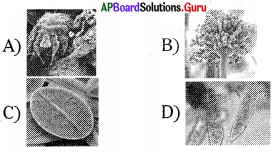
Answer:
D)
Question 52.
Match the following
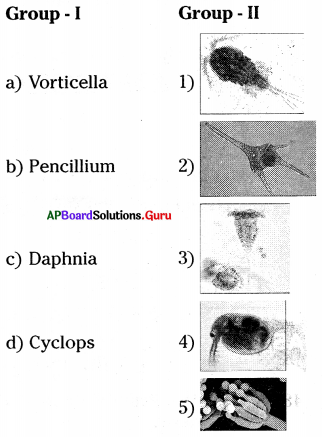
A) a-1, b-3, c-2, d-4
B) a – 3, b – 5, c -1, d – 4
C) a-3, b-2, c-4, d -1
D) a – 3, b – 5, c – 4, d -1
Answer:
D) a – 3, b – 5, c – 4, d -1
![]()
Question 53.
Choose the unicellular organism which is green in colour.
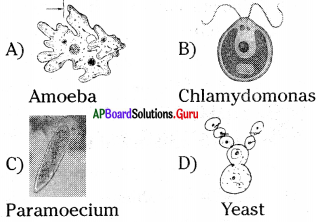
Answer:
B)
Question 54.
Match the following.
1. Bacteria — a) Paramecium
2. Virus — b) E.coli
3. Fungi — c) TMV
4. Protozoan — d) Rhizopus
A) 1 – b, 2 – c, 3 – d, 4 – a
B) 1 – b, 2 – d, 3 – c, 4 – a
C) 1 – c, 2 – b, 3 – d, 4 – a
D) 1 – a, 2 – b, 3 – c, 4 – d
Answer:
A) 1 – b, 2 – c, 3 – d, 4 – a
Question 55.
The following is called a bridge be-tween living and non-living things.
A) Bacteria
B) Viruses
C) Fungi
D) Algae
Answer:
B) Viruses
![]()
Question 56.
Read the below sentences. Select the right statements.
a) All the Fungi species are microbes
b) We can see Bacteria with naked eye
c) Microbes lives in water, air and soil
d) All the Arthropodas are microbes
A) a, b, c
B) b, c, d
C) b and c
D) a and c
Answer:
D) a and c
Question 57.
We can see green colour in stagnated water because of the algae growning in it. But many algae does not see with naked eyes. Identify the algae which can be seen with naked eye.
A) Spirogyra
B) Spirulina
C) Seratium
D) Chlamydomonas
Answer:
A) Spirogyra
Question 58.
Read the statements about micro arthropods.
P) They increase soil fertility.
Q) Causative organisms for skin disease like scabies.
In the above sentences,
A) P is only correct
B) Q is only correct
C) Both P and Q are correct
D) Both P and Q are wrong
Answer:
C) Both P and Q are correct
![]()
Question 59.
Rajesh is trying to observe with the material like black coloured bread, slide, microscope. Guess what he may be observed.
A) Fungi
B) Algae
C) Bacteria
D) Protozoan
Answer:
A) Fungi
Question 60.
Identify the correct order of stages to observe the bacteria in buttermilk.
a) Slowly heat the slide.
b) Wash the slide gently with water after heating the slide.
c) Put a drop of buttermilk on the slide.
d) Drop crystal voilet solution on the slide.
A) a, b, c, d
B) b, c, d, a
C) c, b, a, d
D) c, a, d, b
Answer:
D) c, a, d, b
Question 61.
Read the following stages of making the protozoan slide in the laboratory and identify the correct order.
a) Observe the slide under Micro¬scope.
b) Take a drop of water collected along with the hay.
c) Put cover slip on the water drop on the slide.
d) Soak dry hay for 3 – 4 days into the water.
A) a, b, c, d
B) c, b, d, a
C) d, b, c, a
D) d, b, a, c
Answer:
C) d, b, c, a
![]()
Question 62.
Look at the flow chart. Write correct example in Boxes.
Identify the organisms in A, B, C places orderly.
A) Lactobacillus, Pencillin, Plasmodium
B) Pencillin, Plasmodium, Lactobacillus
C) Lactobacillus, Plasmodium, Pencillin
D) Plasmodium, Pencillin, Lactobacillus
Answer:
A) Lactobacillus, Pencillin, Plasmodium
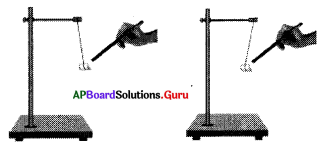


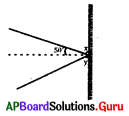
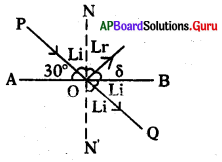





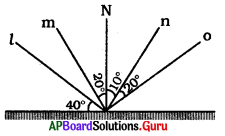
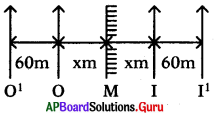



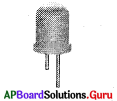
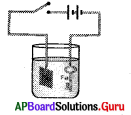


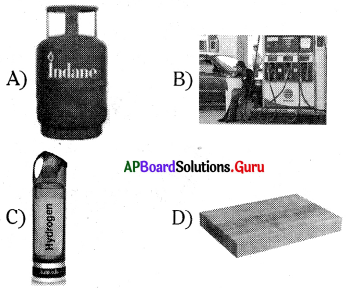
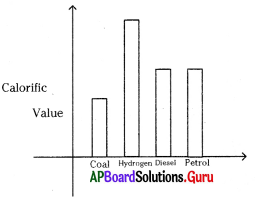


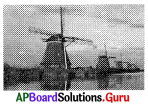



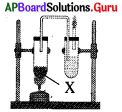
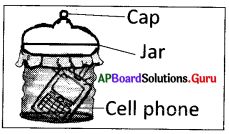



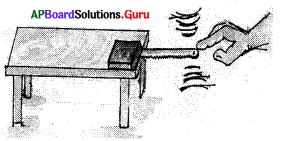


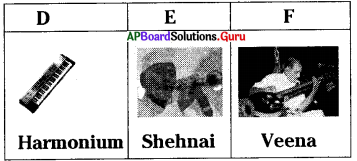


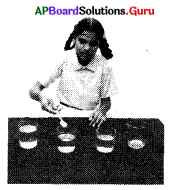
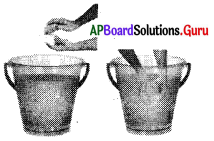
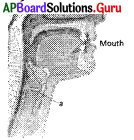



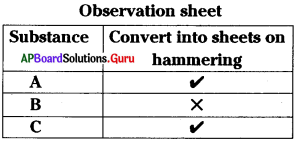

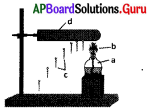
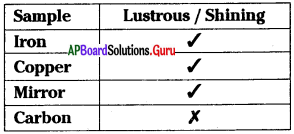

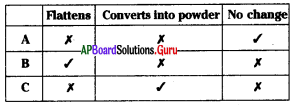

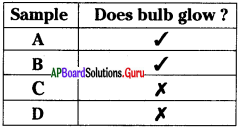

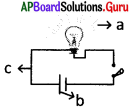
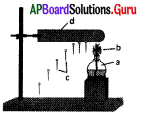

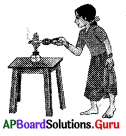
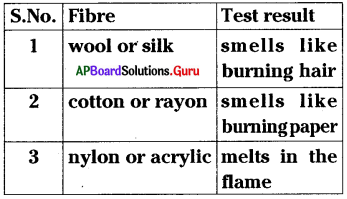
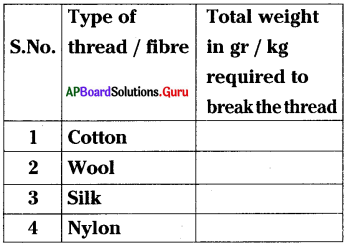

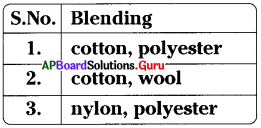



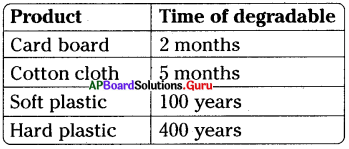

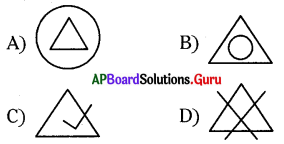

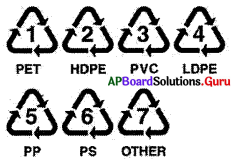
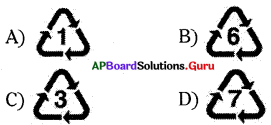


 represents …………
represents …………








